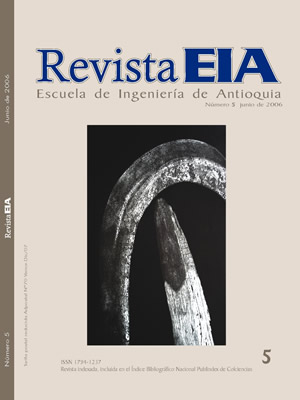CARACTERÍSTICAS CRISTALOQUÍMICAS DE LA HIDROXIAPATITA SINTÉTICA TRATADA A DIFERENTES TEMPERATURAS
CARACTERÍSTICAS CRISTALOQUÍMICAS DE LA HIDROXIAPATITA SINTÉTICA TRATADA A DIFERENTES TEMPERATURAS


This work is licensed under a Creative Commons Attribution-NonCommercial-NoDerivatives 4.0 International License.
Copyright statement
The authors exclusively assign to the Universidad EIA, with the power to assign to third parties, all the exploitation rights that derive from the works that are accepted for publication in the Revista EIA, as well as in any product derived from it and, in in particular, those of reproduction, distribution, public communication (including interactive making available) and transformation (including adaptation, modification and, where appropriate, translation), for all types of exploitation (by way of example and not limitation : in paper, electronic, online, computer or audiovisual format, as well as in any other format, even for promotional or advertising purposes and / or for the production of derivative products), for a worldwide territorial scope and for the entire duration of the rights provided for in the current published text of the Intellectual Property Law. This assignment will be made by the authors without the right to any type of remuneration or compensation.
Consequently, the author may not publish or disseminate the works that are selected for publication in the Revista EIA, neither totally nor partially, nor authorize their publication to third parties, without the prior express authorization, requested and granted in writing, from the Univeridad EIA.
Show authors biography
La hidroxiapatita sintética (HA) es un fosfato de calcio con una composición química muy similar a la del hueso humano, lo cual la hace biocompatible con los tejidos vivos. La biocompatibilidad posibilita su uso en variadas aplicaciones médicas. En esta investigación se realizó un seguimiento a las propiedades cristaloquímicas de muestras de HA sintética tratadas a diferentes temperaturas, las que se sometieron a solución fisiológica de Ringer durante periodos de 5 y de 30 días. La medición de la conductividad y el análisis de las muestras, por medio de espectrofotometría UV-VIS, análisis por ion selectivo, DRX, FTIR y SEM, permitieron mostrar la gran dependencia de la cristalinidad con el tratamiento térmico. La muestra más cristalina se obtuvo a una temperatura de 1050 °C. La mayor solubilidad se presentó en las muestras más cristalinas; además, se evidenció la presencia de dos mecanismos que compiten cuando las muestras se someten a solución Ringer: la disolución y la precipitación.
Abstract: Synthetic Hydroxyapatite (HA) is a calcium phosphate whose chemical composition is very similar to that present in human bones. This characteristic makes it biocompatible with live tissue. Due to this biocompatibility, it is possible to use HA in many medical applications. In this research, crystalochemical properties of HA obtained by different thermal treatments and put later in physiological Ringer solution, during 5 and 30 days, were followed. Conductivity measurement and analysis by spectrophotometric UV-VIS, selective ion, DRX, FTIR, and SEM showed the high dependence of crystalinity of both thermal treatment and higher solubility of the more crystalline samples. Besides, when the samples were immersed in Ringer solution, the competition between two mechanisms, dissolution and precipitation, was reveled.
Article visits 278 | PDF visits 446
